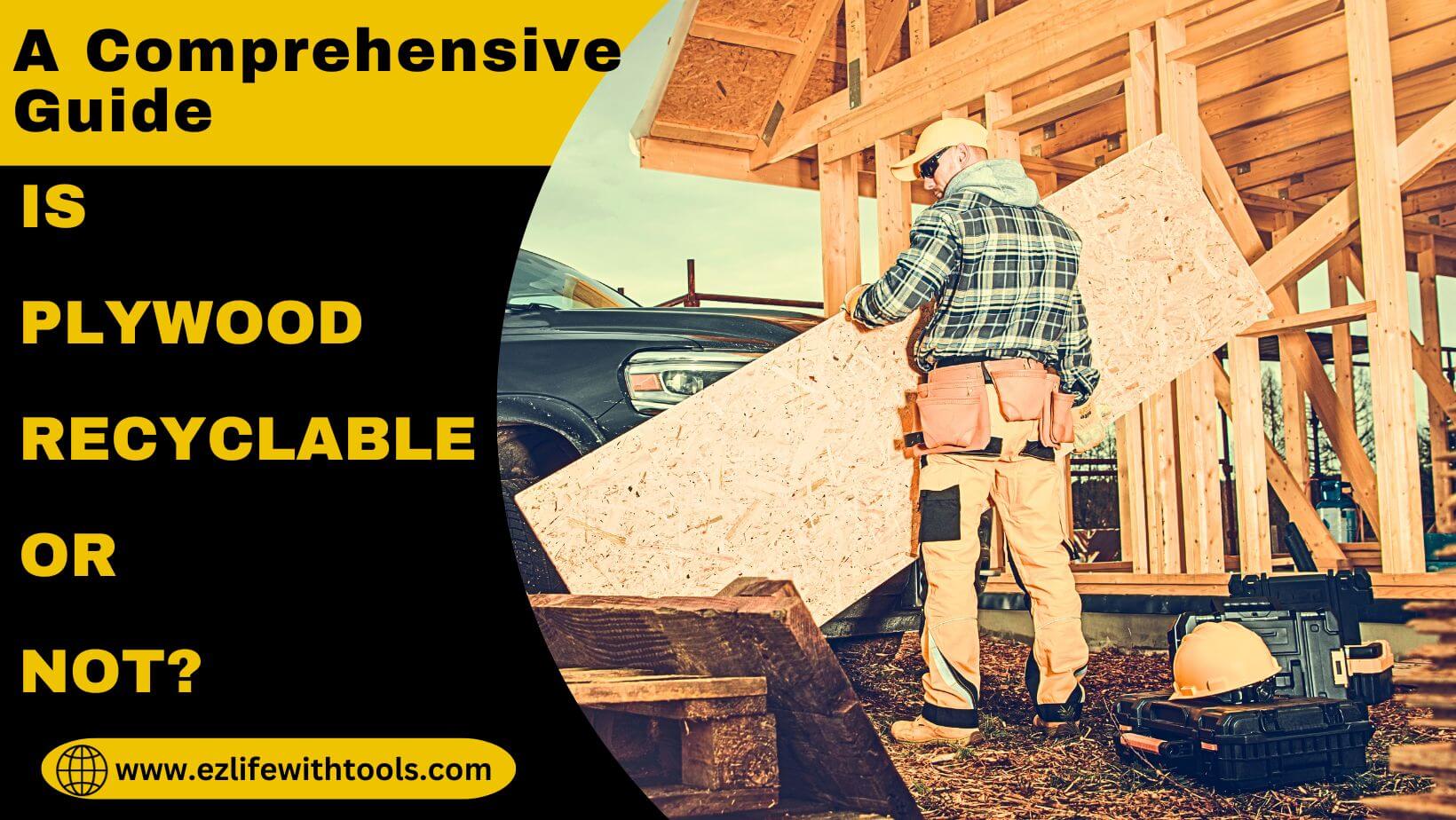Is Plywood Recyclable or Not? Eco-Friendly Perspective

Plywood is a building material that is very popular due to its versatility, strength, and durability. We can find it in any kind of project, like construction, furniture crafting, and DIY projects.
But as a responsible citizen or human being, a question arises in the mind. Is plywood recyclable or not?
In this article, I will explain the intricate nature of plywood, its composition and the recycling process, and its effects and benefits on society.
So, to know every aspect and step of plywood recycling, be attached with me.
What is Plywood?
Plywood is a versatile artificial wood product created by bonding together thin layers of wood veneer with the help of special glue. These individual layers are called “plies”. Plywood is made by gluing together several layers of plies.
Composition of Plywood
To understand the recyclability of plywood, it’s essential to understand what plywood is and how it is constructed.
We have learned what plywood is? Now, we will learn the composition of plywood and how it is manufactured.
Plywood typically consists of three main components.
- Veneer Sheets/Face Veneer
- Adhesive
- Core Material/Veneer
Sheets/Face Veneer
These are the thin layers or sheets called veneer, which are usually made from hardwood or softwood. It is the basis of any plywood, and we can call it a raw material for production.
Normally, the face veneer or front side of the plywood is made of hardwood plywood.
Adhesive
It is a crucial part of any plywood manufacturing process. It works as a bonding material between all veneer layers to create stability and strength in the plywood. Normally, phenol-formaldehyde, urea-formaldehyde, and melamine-formaldehyde are used as bonding materials.
Core Material / Veneer
Between the veneer layers, there is a core material, which can be solid wood, particleboard, or medium-density fiberboard (MDF). It is responsible for the structural integrity of plywood.
Note: All these layers will be strategically arranged to create a composite material because the strength and unique features lie in the orientation of these plies. The strength varies with the direction of the veneer, and it is rotated up to 90 degrees from each other.
This method provides exceptional strength and stability, making it a favored material in construction, furniture, and various applications.
Types of Plywood Recycling Techniques
Plywood is recyclable, but it is more complex to recycle than other wood products due to its composition and adhesives.
Here, I will describe the recycling process in all aspects.
- Mechanical Recycling
- Chemical Recycling
- Upcycling
- Energy Recovery
1- Mechanical Recycling
In this process, plywood will be broken down into constituent wood fibers through processes like chipping, shredding, or grinding. The resulting wood chips can then be used to create new plywood sheets or other wood-based products. It is a sustainable option.
2- Chemical Recycling
In this process, the main aim is to separate the adhesive in plywood from wood fibers. To separate the adhesive, heat, chemicals, or enzymes will be used to clean the wood fibers from resins.
After the whole process, the clean wood will remain for reuse.
But always remember, do not use any harmful chemicals without the advanced technology.
3- Upcycling
It is a very positive way to recycle plywood because in this method, most probably try to reuse it for any creative and decorative purpose rather than converting it into raw materials.
Using this method, the demand for new materials can be reduced and give old plywood a new life.
4- Energy Recovery
If we find that recycling plywood is impossible due to contamination or other factors, we can use it as an energy source through burning. Plywood can be burned, but it should be the last option for us to reduce the waste in landfills.
Is Plywood Recyclable or Not? Eco-Friendly Perspective
Recycling Process of Plywood
You can start this process by following these simple steps. Let’s get started.
- Collection: First, old or discarded plywood is collected from construction sites or recycling centers.
- Sorting: Plywood is sorted based on the base’s condition. Reusable pieces can be saved for further use while damaged or unusable pieces are separated.
- Deconstruction: Plywood panels are broken down into their constituent materials, including veneer sheets and adhesive.
- Recovery: Recovered wood can be used in particleboard or converted into fuel through processes like wood chipping or pelletizing.
- Adhesive Separation: The adhesive can be challenging to recycle. Depending on the type of adhesive used, it may undergo chemical processes for reuse or energy recovery.
Environmental Impact of Plywood Recycling
Here are some factors; the environmental impact of plywood recycling can be assessed by considering these factors.
Resource Conservation
We know very well that the main source of plywood is trees, and tree growth is a very difficult task that takes a very long time.
So, we can conserve valuable wood resources due to the recycling process. Not only wood resources but also new adhesives because adhesive product production impacts our environment.
Emissions Reduction
In producing new plywood, many greenhouse gases are produced that badly affect our atmosphere.
But if we recycle the old plywood and use it for any other purpose, we can minimize greenhouse gas production. It will save not only our society but also the sea level, wildlife, and agriculture.
Waste Reduction
Plywood recycling is the best way to reduce the extra waste on earth and reduce many disposal issues of landfilling because solid waste disposal is a huge problem.
Innovations in Plywood Recycling Techniques
In recent years, there have been exciting innovations in plywood recycling, making it a more environmentally friendly method.
Adhesive Alternatives
As a result of research efforts, new adhesives have been invented that are more environment friendly and easy to recycle. These innovations will reduce the environmental impact of plywood production and recycling.
Advanced Separation Technologies
One another explored advanced technology, which is laser cutting and ultrasonic technology, used to separate the wood fibers from adhesives more precisely and effectively. It will minimize the bad impact of recycling plywood on the atmosphere.
Conclusion
Whether is plywood recyclable or not was really a question that needed to be explained. So, plywood is a recyclable material, but this process is not straightforward compared to other materials.
Although recycling challenges exist, but efforts are continuing to improve the recycling method to reduce the environmental impact.
Plywood recycling has multiple benefits, and all are described above.
So, the next time you consider using plywood in your construction or woodworking project, remember to choose recycled plywood because it can play an important role in reducing the environmental impact.
Thank you for your time.
Best Wishes
Frequently Asked Questions
Is plywood made from waste?
NO, plywood is made of thin layers of real wood using adhesive between the layers to join all together.
Is plywood bad for the Environment?
Environmental impact of plywood depends on different conditions like source of plywood material, used chemicals and process. So, it can vary according to the situation. If it is made by a responsible source of materials and process, it will minimize the chances of bad effects on environment.
Why is plywood biodegradable?
Plywood is not biodegradable, it is recyclable. But source of all plywood raw material is biodegradable. Then why plywood is not biodegradable, because plywood is made by the thin layers of wood with the help of adhesive chemicals. These chemicals are resistant to biodegradability.

